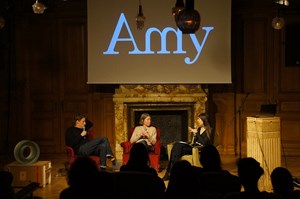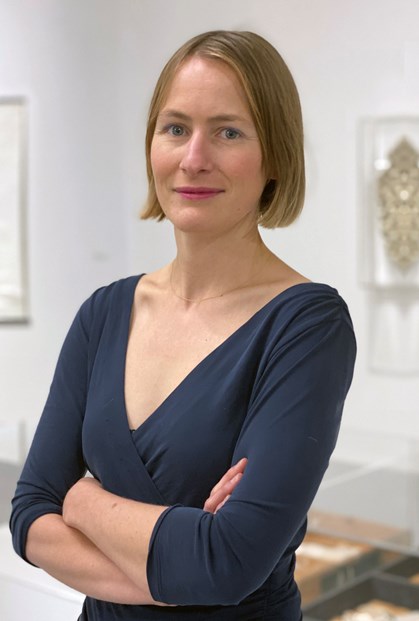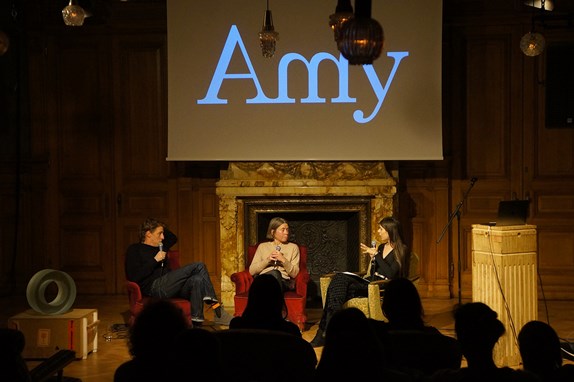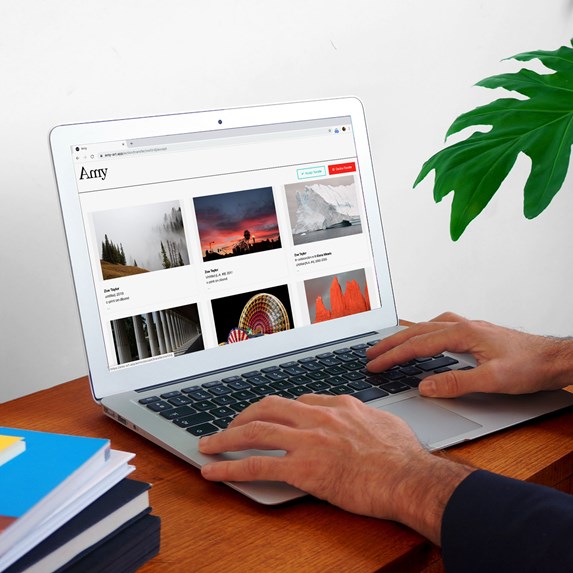
Like almost every other industry, the art world is doing its best to become digital – quickly. The team behind Amyart.app have been working in the world of professional art for several years. Together, they decided to create a tool to help art enthusiasts and dealers manage and present their work.
Image courtesy to Amyart.app, Femke Cools
Like almost every other industry, the art world is doing its best to become digital – quickly!
The team behind Amyart.app have been working in the world of professional art for several years. Together, they decided to create a tool to help art enthusiasts and dealers manage and present their work.
The app provides an overview of artworks and contacts as well as upcoming actions such as exhibitions, purchases and sales. The app also allows users to create PDF or Excel sheets for any information that they want to share, such as price lists or portfolios. Users can also choose to display their works in a digital private viewing zone or a public wall.
ArtDependence spoke to Co-Founder Femke Cools to find out more.
ArtDependence (AD): What was the original inspiration for Amyart.app?
Femke Cools (FC): Everyone on our team has worked in the art world for a long time. All of us worked in galleries, in artist’s studios or as artists and closely with collectors. Together, we have over 35 years of experience.

Image courtesy to Amyart.app, Femke Cools
Dealing with artworks and everything surrounding them in all of these capacities, we constantly bumped into a multitude of issues. All of the ups and downs that can possibly happen, we encountered. What we found was that most of the time, the problem was that necessary information wasn’t available, or it flowed too slowly or picked up errors when changing hands. This not only has organizational consequences, but also seriously impacts the financial side of the business and the professional relationships.
In the art world, personal relationships based on trust are still the driving force behind the sector. Deals are still made with a shake of a hand, but this doesn’t mean there shouldn’t be structured organization behind it. This is actually what makes a systematic approach even more necessary. It’s what facilitates these professional relationships.
We also had to deal with a lot of changes in the work force. This is a well-known issue, common in the sector. Often people work at one place for a year or so before changing quickly to their next position. This demands that the foundation of the organization needs to be as solid as possible. No matter how small it is, it needs to be resilient to this flexible and dynamic environment. A lot of things you do depend on information. We can’t stress enough that this information can't just be in people’s heads. That would be extremely dangerous, because there’s always somebody else that needs to work with that information.
On top of that, we also realized that information about an artwork plays an important role in its value. Obvious things such as: is it unique or is it an edition. Or what are the exact measurements? The less tangible things are also important as well. What is the complete exhibition history of the artwork? What’s the works provenance? All these things contribute to its value. And we’re not only talking about its market value, although this is necessarily a big part of it. But its historical, artistic and personal value as well. All these things led us to think about creating a solid structure that captures all of this valuable information. And because we are realistic and pragmatic people, we know this requires a tool that does this, not only in a complete way, but also in an easy, user-friendly way. Otherwise people simply won’t do it and critical information will get lost.

Image courtesy to Amyart.app
AD: Did you change your idea much during development?
FC: The initial idea didn’t change much but it expanded exponentially. This mainly had to do with the fact that once we started, we realized just how much expertise we actually had accumulated. The things we took for granted in our daily dealings with art actually involved a lot of knowhow to organize once you looked at them clearly. We also could have written a handbook, but realized that the best way to learn these things is by really doing them.
With that in mind, we tried to create software that is not just another tool. It functions more as a guideline into the specifics of dealing with art on a daily basis. It’s a practical way to handover our expertise to our customers. Of course, there are always ideas we would like to develop in the future to expand the toolkit and make it even more complete, while still keeping an eye on a user experience that is easy and accessible. One thing we learned is that you never stop tweaking and expanding. The biggest change we made was rewriting the original tool as a cloud-based app. We had somewhat struggled in finding a way to help out those galleries, artists and collectors who were just starting out or had not yet reached that highest 1% level. They are not able to access a lot of tools mainly due to development and installation cost. And it’s these people who probably need this kind of help the most. We knew of friends and colleagues who could really benefit from this kind of help but it was simply beyond their budget. We went back to the drawing board and solved it with an online app that’s cloud-based, accessible from every device and extremely affordable.
AD: What has surprised you most about launching an app?
FC: We knew from our own experience there was a great need for something to help people get started. Something they could turn to and rely on to keep track of everything that surrounds an artwork. We underestimated the enthusiasm. Especially from organizations and people who we hadn’t thought of it before. The reaction from other people came as somewhat of a surprise. We had been working on this for a while. It was so obvious to us that we had probably taken it for granted. It was hard to think back to a moment before this. How did we ever get things done before? It’s a bit like when the first electrical screwdriver came to the gallery. All of a sudden opening a crate was no longer something that you worried about. You get used to it so fast. We were somewhat surprised to hear that a lot of people were still new to this idea of an art management toolkit.
AD: What do your users find most useful about Amyart.app?
FC: We started out with the idea of an assistant for a gallery, an artist studio and a collector. Only to find that with Amyart.app we had created something that helps everybody who’s into art to manage their art activities. For example, curators keep track of works they love and want to work with, insurance agencies keep track of the works they are insuring, art transporters get an overview of what they are transporting to where. The list goes on.
For our users, Amyart.app is a tool that helps them get completely organized the right way. A kind of checklist of everything they need to think about when dealing with artworks. Sometimes it’s easy to forget how we could use some guidance with the basics. But also, we know that people really appreciate the feature tools too. For example, we have a transfer module that allows artists to send information about an artwork straight to the gallery’s Amy account. In a few clicks, the gallery can start to work with all the correct and up-to-date information about the artwork and start adding its own information. In its turn, the gallery can send that information to the collector once the work is sold. Information flows immediately and without errors. When people use this feature for the first time, it’s almost magical to see these works appear with all the correct info.

Image courtesy to Amyart.app
AD: Do you think technology as a whole is helpful for the art world, or is it changing the art world?
FC: Technology is changing all sectors and ways of interacting. There really is no way around it. The question for us is all about functionality. Technology should be a way to do what you want to do with more efficiency and accuracy. We put a lot of effort into creating an open and flexible system. This means that we understand art is extremely diverse. That’s actually what makes it so interesting. However, that also poses a real challenge when thinking about structuring information. Where often technology wants to impose its system onto the user, we created a lot of solutions where the user is actually in charge. We developed ways to allow for detailed and complex information, without losing sight of user experience. The basics are very easy, meaning users can start with a simple database containing an artwork title and an image. That’s already a great first step in getting organized. But when you need that next level, Amyart.app allows for easy ways to implement complex exceptions and customization. Technology will only help the world if it really assists in doing your job. It should supercharge your workflow in a practical way.
AD: What technology is inspiring you at the moment? What tech do you think we should watch out for over the next 12 months?
FC: In the art world we think more about working combinations of technology. A strong back office such as Amyart.app to manage all your activities in a coherent and easy way. Combine this with a fast frontend that allows you to interact with your audience. Managing the right information on the one hand while getting that information out there quickly, easily and to the right people. Next to the personalized proposals and transfers you can do with Amyart.app, Instagram comes to mind here as we work in a visual environment.
AD: What are the most used features?
FC: What we hear from our users is that the basics are pretty solid and easy to use. It covers a lot of their daily tasks. As mentioned, the transfer module is unique with Amyart.app and very useful. Also, our extreme attention to safety is very much appreciated. Cloud applications naturally raise questions about security. A lot of information is extremely sensitive. Our clients are reassured when they know we use the same servers as a lot of banks. Meaning that this is the highest you can get when talking about security levels. On top of that, our users understand the value of being able to customize work processes. As mentioned, some of the small things can really grind your work to a halt. For example: what to show on your export. Amyart.app allows you to create all kind of export templates such as portfolios, caption list, price lists, transport lists and more. You can customize all of this output to your specific needs. You need a portfolio with mention of the specific edition size? No problem. But you need it tomorrow without that info? Click and it’s done. Once you’re ready to create output, you can decide in unlimited ways what’s visible and what’s not. Another example of customization is price types. Users have a lot of different price types that are specific to their way of working. All this information can be organized easily in Amyart.app. Or you can keep a photo of the back of a painting for your archive. Sometimes this is crucial information, but you don’t want this on your portfolio. We understand there’s a big difference between maintaining your personal archive and just being able to print a portfolio. Because we’ve encountered all these issues ourselves, we are really thinking about easy workflows for all these needs. We live in a world where information is transferred, saved, edited, expanded, transferred again and presented in customized formats. All this in a few quick clicks. And this is what Amyart.app does for everybody.

ArtDependence Magazine is an international magazine covering all spheres of contemporary art, as well as modern and classical art.
ArtDependence features the latest art news, highlighting interviews with today’s most influential artists, galleries, curators, collectors, fair directors and individuals at the axis of the arts.
The magazine also covers series of articles and reviews on critical art events, new publications and other foremost happenings in the art world.
If you would like to submit events or editorial content to ArtDependence Magazine, please feel free to reach the magazine via the contact page.